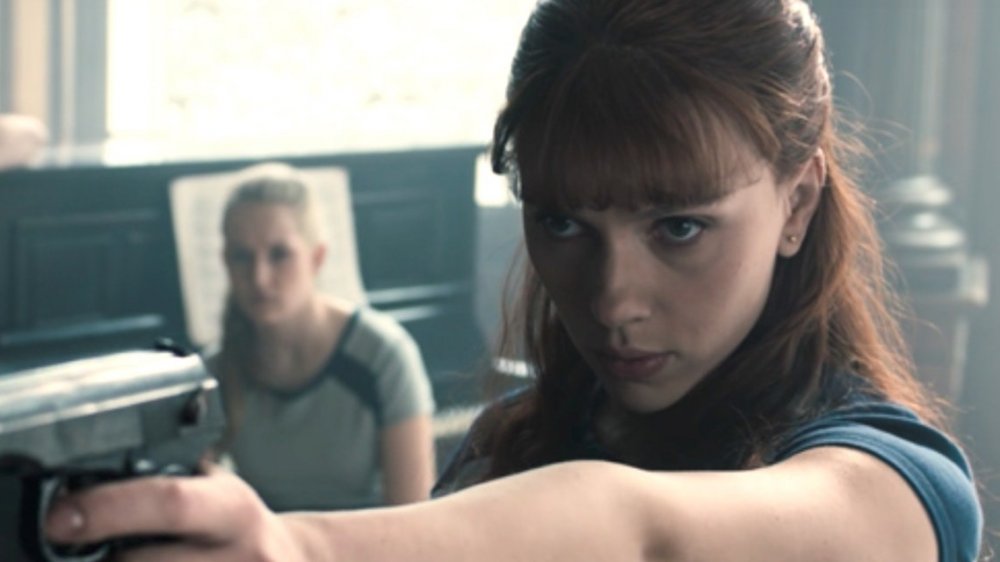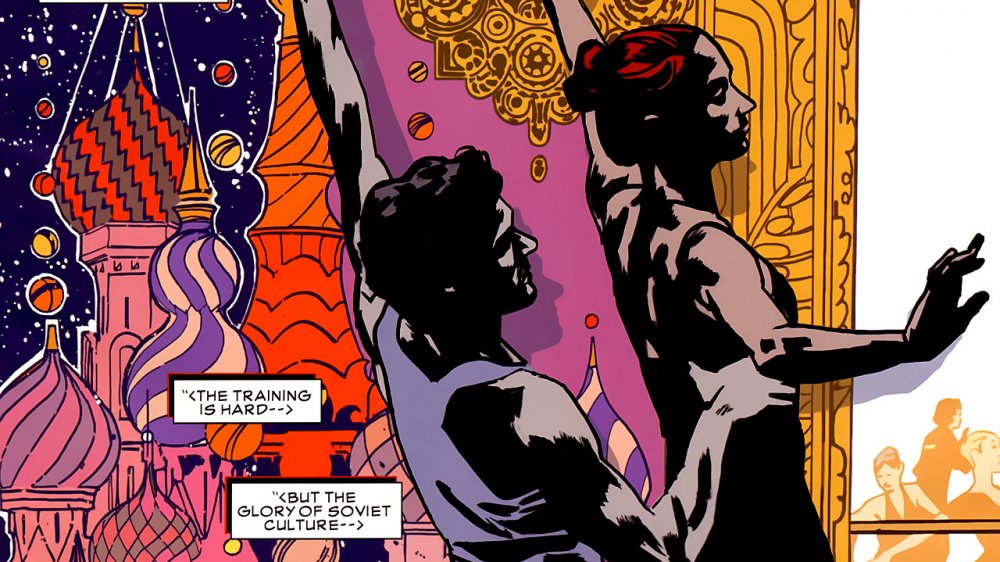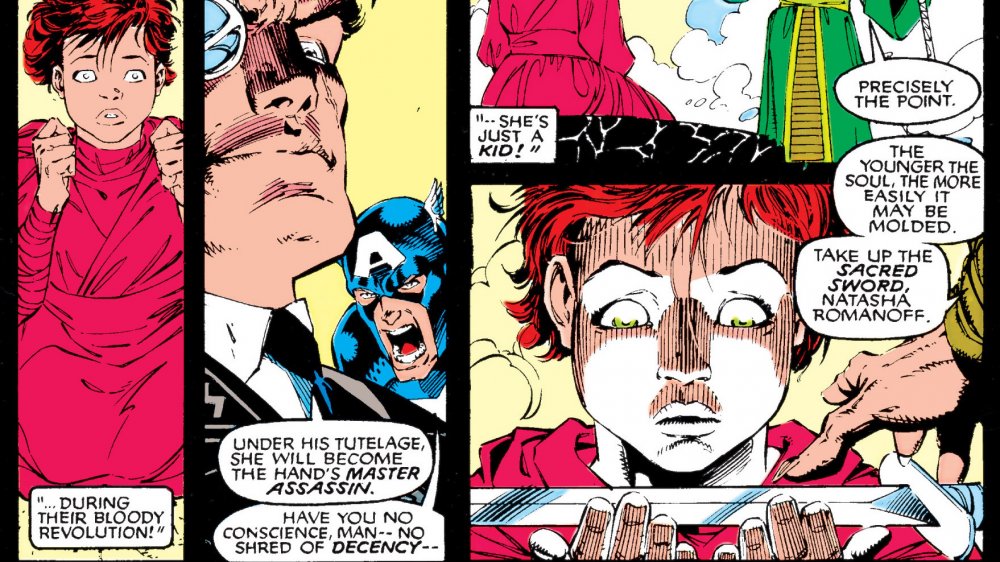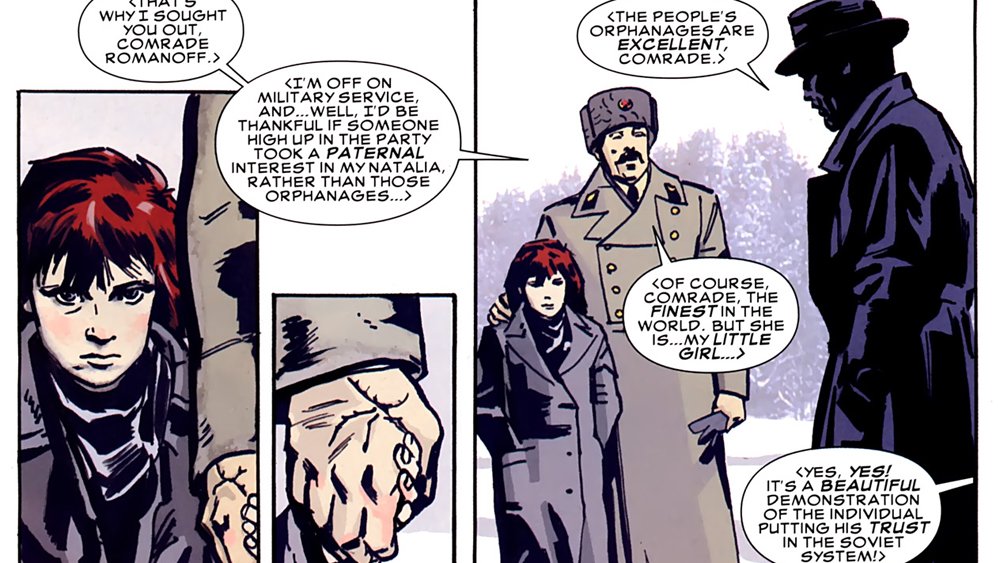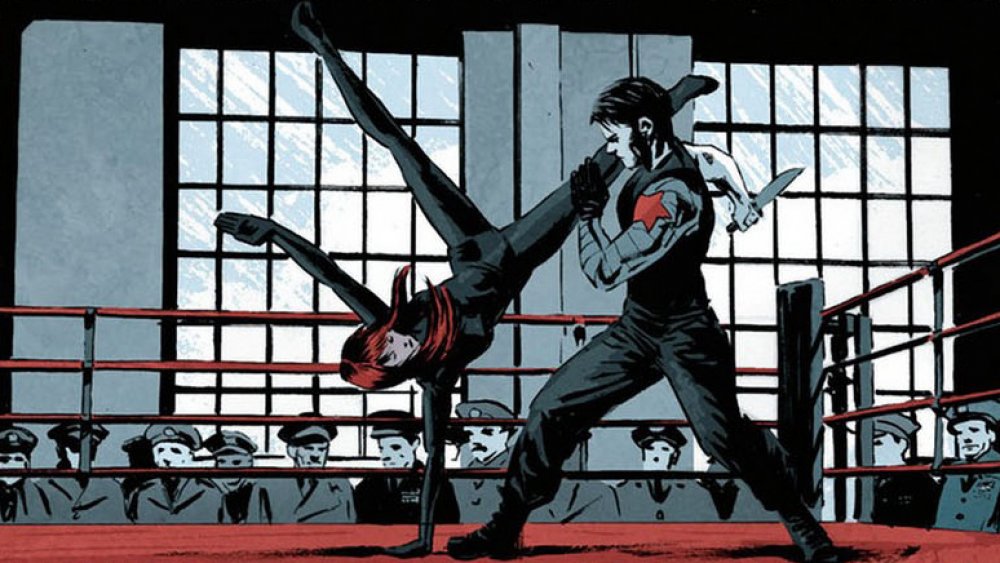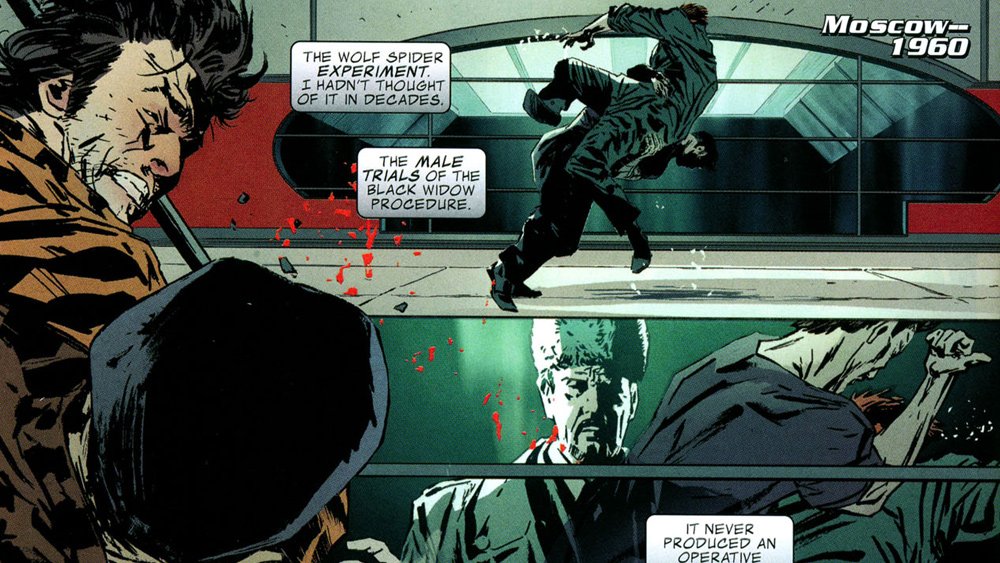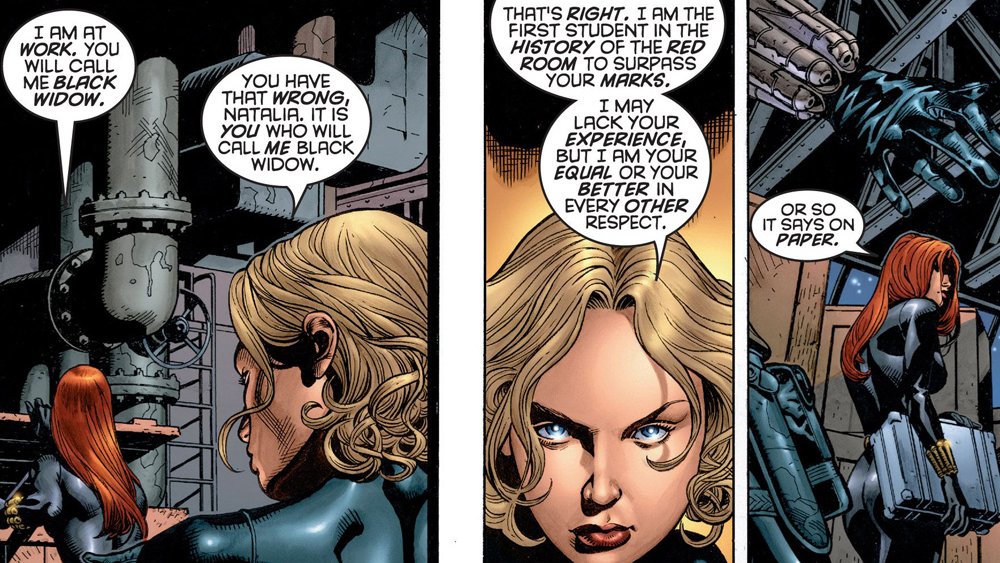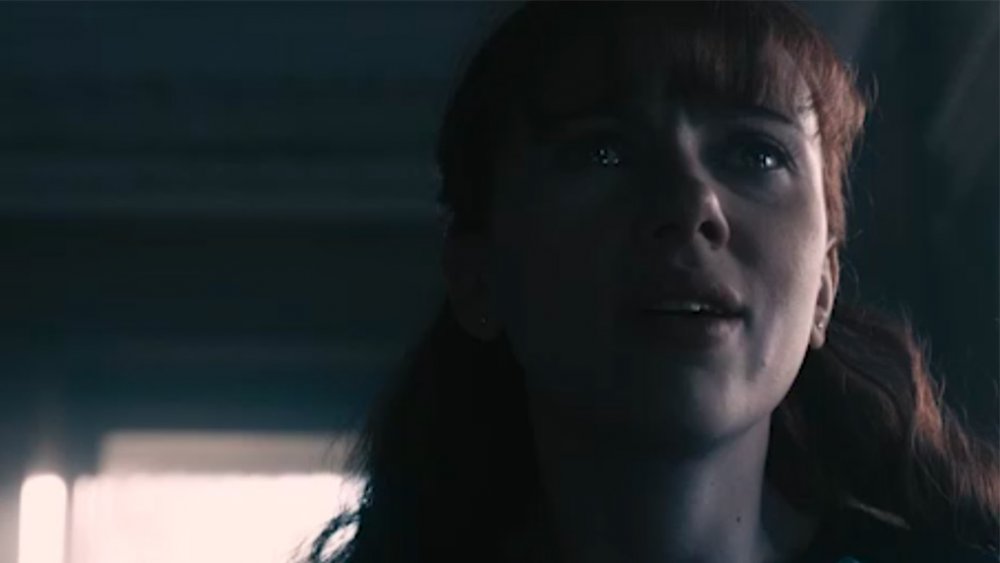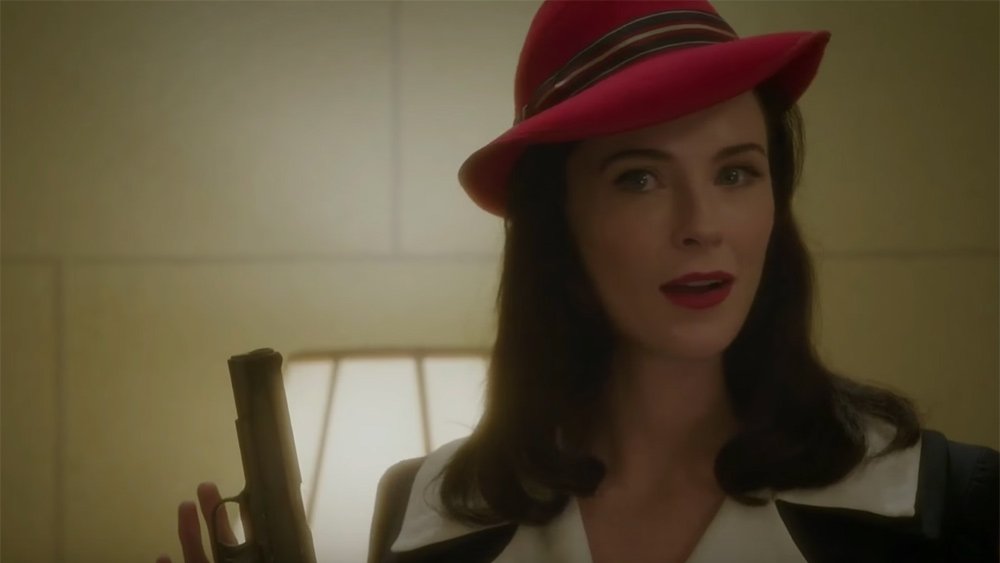The Untold Truth Of The Red Room
In the Marvel Universe, it seems like every country on Earth has its own program designed to create the perfect super soldier. Even Canada has the Weapon X program, which has turned out way more killer operatives with knives for hands than you might expect from a country where the biggest national trait is politeness. And really, why wouldn't they? After all, the Super Soldier Serum took a sickly weakling named Steve Rogers and turned him into one of the greatest superheroes on Earth, a living legend who's capable of going toe-to-toe with gods, monsters, super-villains, and even werewolves that one time in the '90s. Everybody's going to want one of those if they can get them.
However, the most sinister of these programs by far is known as the Red Room. A Russian holdover from the Cold War, it's the institution that gave an orphaned girl the deadly skills that turned her into the Black Widow, and it took one of America's most patriotic heroes and brainwashed him into becoming the lethal Winter Soldier. For the twisted history of the Red Room, though, those two characters are only the beginning.
The Red Room is the most secret of secret projects
In the continuity of the comics, the Red Room dates back to at least World War II, with a part to play in the countless conspiracies bubbling just under the surface of the Marvel Universe. Here in the real world, though, the Red Room didn't make its first appearance until 1998, which is pretty surprising when you consider that its most famous student had been a major character in the Avengers for about 30 years at that point.
Before Shadows & Light #1 hit the shelves, Black Widow's origin was relatively simple, at least by comic book standards. Before she was a superhero, she was a supervillain — she fought Iron Man back in her first appearance — and before that, she was just Natalia Romanova (aka Natasha Romanoff), the star ballerina in the world-famous Bolshoi Ballet and married to a military pilot named Alexi Shostakov. When Alexi died in the line of duty, Natalia signed up with the KGB, using her finely honed physical skills and a knack for martial arts to train as an assassin, and taking the name Black Widow because she somehow knew that Americans were terrified of spiders, and because, you know, she was literally a widow.
Except that she wasn't. For one thing, Alexi had never actually died. The KGB had faked his death to turn him into the Red Guardian, the Soviet counterpart of Captain America, which made things pretty awkward the first time he was reunited with his wife, a not-so-happy event that came when he fought both Black Widow and her new boyfriend, Hawkeye. That's just the tip of this particular communist iceberg, though. While it might seem like it would be prohibitively difficult to disguise someone as a member of the world's most famous ballet company, Natalia had never actually been a ballerina, either. Those were false memories implanted during her training, leaving us with a pretty compelling question: If that wasn't actually Black Widow's origin, what was?
Starting early
One of the more interesting pieces of the Red Room puzzle came in Uncanny X-Men #268. If you think of "Marvel Comics" as not just a company but a sort of signature aesthetic that's been running through those books ever since Jack Kirby and Stan Lee introduced the world to the Fantastic Four, then this is quite possibly the most "Marvel Comics" story ever printed.
The story is a team-up starring Wolverine that takes place in two different eras. One half of the story happens in the present day of 1990, when Wolverine and Black Widow team up to take on the evil ninjas of the Hand, who are stirring up trouble in Madripoor and out for revenge against the Widow after a prior clash that involved Daredevil. The second half of the story takes place 49 years earlier, in 1941, when Wolvie teams up with Captain America to, well, also fight the Hand, who are stirring up trouble in Madripoor. Back then, however, there was one more wrinkle to the story. The trouble being stirred up was in the form of a young girl that was kidnapped from Moscow by Baron Strucker and given to the Hand in order to be raised into their deadliest assassin due to her "extraordinary aptitude for the martial arts." Her name? Natalia Romanova, the girl who would grow up to be the Black Widow.
If you've been paying attention, you might've already caught on to a pretty notable quirk to this story. The Widow was a young girl — somewhere around ten years old judging by the art — in 1941, and she was still out there fighting bad guys as an Avenger 50 years later, looking like she was maybe in her early 30s at most. That's not all that unusual in the Marvel Universe, but unlike the characters with whom she shared that story, the Widow doesn't have a mutant healing factor, and she didn't spend years frozen in a block of ice to explain the apparent discrepancy. Dancers tend to age pretty gracefully, but there was clearly something more going on with her backstory than a stint in the ballet that led her to the KGB.
Li'l Orphan Natty
Black Widow is pretty unique character for a few reasons, but one of the most notable is that unlike most of Marvel's top-tier mainstays, she doesn't actually have a definitive, set-in-stone origin story. That's especially odd when you consider that they literally published a comic called Black Widow: Deadly Origin back in 2010. She's maintained an air of mystery for over 50 years, largely because her training involved the Red Room altering her memories to suit their own sinister purposes.
The facts, at least until the comics reveal the next hammer-and-sickle shaped twist to her backstory, go a little something like this. In 1928, baby Natalia was rescued from a burning building in Stalingrad by Ivan Petrovich. Ivan was told by Natalia's caretaker — who died in the fire, sacrificing her life to save the baby and taking any of the facts about her young charge's history with her — that li'l Natalia was "a Romanoff." That naturally hinted at a possible connection to Russia's lost royal family, who were seemingly all executed ten years prior in the Russian Revolution. For more information, please see the truly depressing opening to the 1997 animated film Anastasia.
That connection, however, would never be fully explored. Instead, despite Ivan's protests, Natalia was declared an orphan in 1940, and on the order of Joseph Stalin himself, sent to a new training facility where she proved to be so adept at learning to kill that the Hand tried to steal her away and Wolverine had to get involved. The weird thing is, Wolverine apparently knew all about this, and despite his well-chronicled tendency to adopt young women as a surrogate father figure, he left her in the care of the KGB ... along with her 27 "sisters."
Mistaken identities
While she would become its most successful product, Natalia Romanova was certainly not the only young girl trained in the deadly arts of assassination by the Red Room and its masters in the Soviet Union's sinister Department X. Instead, she was one of 28 "students" (aka Widows), all of whom were orphaned girls who had the falsified memories of being dancers for the Bolshoi Ballet.
The architect of this brainwashing was Department X's leader, Vasily Karpov. Under his direction, Department X recruited a "psychotechnologist" named Grigor Pchelintsov, who'd invented the technique of implanting false memories. Together with a "programmer" known only as "Professor Radchenko," who later defected to the United States, he implanted the Red Room's students with their false memories, designed to turn the girls into sleeper agents who could pass undetected in other countries. Unfortunately, there was a pretty big flaw in the program. The process itself was torturous, and the results weren't quite as undetectable as they wanted, especially since the conflicting memories would sometimes try to assert themselves at the same time, leading to the Widows giving multiple answers to the same question.
The mental modifications weren't the only ones, though. The Red Room's staff also featured Lyudmila Kudrin, a chemical scientist and geneticist. Her work resulted in the drug treatments that gave Black Widow her unnaturally long lifespan, as well as causing a biological response that would prevent the women of the Red Room from ever giving birth because "we wanted warriors, not mothers." She also designed a pheromone treatment to keep the trainees docile, programming them to be unable to attack their superiors should they ever get the urge to rebel.
The Red Room and the Winter Soldier
The Red Room was crawling with psychotic Soviet bigwigs, all of whom planned on turning these 28 girls into ruthless killers. However, there was another notable member of the Red Room's faculty, although calling him a member of the staff is pushing it. He was another one of Comrade Karpov's pet projects, and he was responsible for putting Natalia and the others through a vicious round of advanced combat training. He was a pretty effective teacher, too, although that's to be expected. After all, he learned to fight from Captain America.
His name, of course, was James Buchanan Barnes, better known at the time as the Winter Soldier. Karpov was the one who'd fished Bucky out of the ocean after his presumed death in 1945. Using the same technology that he'd employed to implant false memories into the Black Widows, he erased Bucky's old patriotic personality and turned him into a mindless, ultra-efficient killing machine.
The Wolf Spiders
While both were under the purview of Department X, the Winter Soldier program and the Red Room were kept separate, with Bucky's side gig as a combat instructor being their only real crossover. There's a reason for that, too. The Red Room was focused exclusively on women.
Except, of course, for the one time that it wasn't. For a brief period, the Red Room experimented with a counterpart to the Black Widow program involving boys. In keeping with the arachnid naming convention, these agents were code-named "Wolf Spiders," and they received similar training and conditioning. Considering that the Red Room's most prominent graduate wound up defecting to America where she joined both S.H.I.E.L.D. and the Avengers, it might surprise you to learn that the Wolf Spider program was apparently even less successful.
The Wolf Spider program only produced a single graduate: Niko Constantin. Rather than send him on missions, the Russian government simply scrapped the project and sent Niko to a Siberian gulag where they dumped all of their super-powered problems. It was there, decades later, that he crossed paths with Bucky, who'd trained him as well. The exact circumstances of his dismissal were never actually revealed other than Bucky mentioning that he was "psychotic" after his conditioning, but it was established that unlike the Black Widows, he never got the chemical treatment that slowed his aging.
Yelena Belova: Widow 2.0
After their success with Natasha Romanoff and the dismissal (and eventual murder) of her 27 classmates, you might've expected the Red Room to continue on, transforming into a super spy factory that was churning out ballerina/assassins every few years. That wasn't the case, though — at least not at that scale. The program did continue, but it only produced a handful of graduates.
The most notable, at least as far as Romanova was concerned, was Yelena Belova. The big difference this time around, though, was that Yelena didn't go through the mental conditioning that her predecessor had. Instead, her fanatical devotion to the cause came naturally. On paper, her scores exceeded Romanova's, and her training cultivated a talent for spycraft and assassination, honing her into a living weapon to the point where she was officially given the "Black Widow" code name. Needless to say, this brought her into a conflict with her predecessor as she attempted to take her place permanently.
The irony was not only that Yelena would never be the only Black Widow, but that she wasn't even the only Yelena Belova. In an effort to cut through the time-consuming process of rounding up athletic orphans, the Red Room began embarking on a new tactic — cloning their best operatives and just programming their brains directly rather than overwriting existing memories. After discovering the truth about her own origin, a clone of Natalia that had activated after the genuine article's apparent death began to work against the program. The Natalia clone began to use the Yelena clones for her own purposes, and in the ultimate insult, she killed the real Yelena in the process to make things easier. It even happened off-panel.
The Unstoppable Wasp was once a part of the Red Room
One of the more recent graduates of the Red Room is Nadia van Dyne, whose origin story reveals that if the Red Room couldn't find enough orphans to train, they'd just make a few of their own. Nadia is the daughter of Hank Pym — the original Ant-Man — and Maria Trovaya, his first wife, who was introduced in a flashback all the way back in 1963. In that story, it was revealed that she'd been kidnapped and murdered on their honeymoon, leaving Hank understandably enraged and heartbroken.
Over 50 years later, it was revealed that Maria's murder (at the time) was faked, and that she'd stayed alive long enough to give birth to her daughter, Nadia, who was given to the Red Room as their latest project. Nadia had apparently inherited her father's genius, and the Red Room leaned into that. Rather than simply manufacturing a super spy, Nadia's branch of the Red Room was focused on an attempt to essentially create mad scientists, hoping to control the next generation of minds brilliant enough to do things like build Iron Man armor or time machines. To that end, the Red Room's trainers encouraged Nadia by revealing her parentage. Unfortunately for them, telling Nadia about her famous American superhero father had the side effect of fueling her desire to escape, which turns out to be pretty easy when you have access to size-changing Pym Particles and the brains to use them.
After her escape, Nadia was mentored by her stepmother Janet van Dyne, better known as the Wasp. Inspired and nurtured for the first time by someone who didn't want to use her brilliance for world domination, Nadia took both Janet's superheroic identity and her last name for her own, changing her name Nadia van Dyne and leaping into action as the all-new Wasp.
The Red Room in the MCU
In 2012's Avengers: Age of Ultron, we got our first glimpse of the notorious Red Room. There's a sequence where the Avengers find themselves trapped in hallucinations induced by the Scarlet Witch, based on each of their memories. Captain America finds himself sharing that missed dance with Peggy Carter, Thor stumbles through a vision of reveling in an Asgardian mead hall, and the Black Widow relives her training in the Red Room.
Interestingly, we see both sides of her education, watching as she's trained both as a ballerina and an assassin. The question we're left with is how much of it is real. We can assume the martial arts side of the training definitely happened because, you know, we've seen the rest of her appearances in the MCU and watched her fight aliens that also provided a reasonable challenge for the God of Thunder. As for whether the ballet was part of that training or just the implanted memories of a cover story, we're still unsure, even after watching Black Widow.
As for the prequel film, it's here we learn that the master architect of the Red Room and the Black Widow program is the evil General Dreykov. And when — spoiler alert — Natasha defected to SHIELD, she and Hawkeye tried to blow him to kingdom come (which gave way to infamous debacle that was "Budapest"). With Dreykov now out of the equation, Natasha thought she'd ended the Red Room for good.
Unfortunately, years later, our hero discovers that Dreykov survived the assassination attempt and has started up a Red Room 2.0, one that uses chemical mind-control technology, courtesy of Natasha's "adoptive mother," Melina Vostokoff. Crazier still, this new version of the Red Room is located way above the ground in a high-tech sky base, which is how Dreykov has stayed off Natasha's radar for so long. Thanks to his fancy new digs and his new brainwashing abilities, Dreykov has installed Widows around the world and uses them — along with his most valuable asset, Taskmaster — to topple governments and alter economies. Fortunately, Natasha and her family (Yelena Belova, the Red Guardian, and a newly converted Melina) bring the Red Room down, freeing most of the Widows and ending the program's reign of terror in the MCU once and for all.
Dottie Underwood is the Red Room prototype
The dreamy hallucination of Age of Ultron isn't the only time we've seen the Red Room in the Marvel Cinematic Universe pre-Black Widow, and Natasha Romanoff isn't the only graduate who's stepped into the spotlight, either. Decades before Nat took her undercover job as Tony Stark's personal assistant in Iron Man 2, Agent Peggy Carter crossed paths with the Red Room protoype, Dottie Underwood.
Played by Bridget Regan, Dottie was one of the primary antagonists of Agent Carter, a spy who infiltrated Peggy's life in order to eventually take her out for the Russian government. Even by the standards of the Red Room, the glimpses we see of her training were especially harsh. In 1937, a young Dottie killed her only friend in a sparring match, ordered by her trainer to choke her to death in a promising display of her lethal talents. Needless to say, Dottie wasn't particularly well-adjusted as an adult, and her fixation on Peggy was packed with moments that were as full of danger as they were of sapphic subtext.
